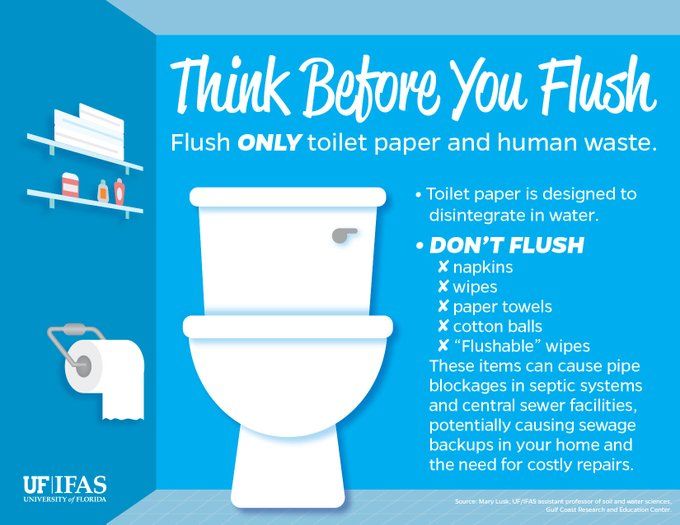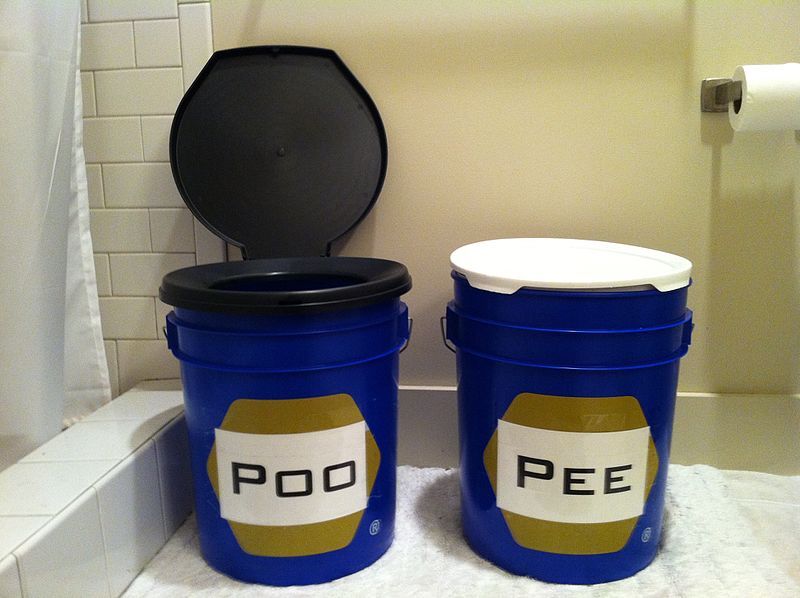Introduction
More than 2 million homes in Florida rely on septic systems to treat household wastewater. The most common type of septic system is made of two parts: a septic tank and a drainfield (Figure 1). Wastewater from a home (including toilet wastes, bath and shower water, and laundry and dish water) collects in the septic tank, where solids settle to the bottom and the liquid then slowly moves outward to the drainfield to percolate through the underlying soil (Toor, Lusk, and Obreza 2011). The liquid (sometimes called “effluent”) is cleaned of many harmful substances as it percolates down through the drainfield soil, but the effectiveness of this process is dependent on the septic system being regularly maintained and the drainfield soil being adequate for the type and volume of waste coming from the home. Some areas of Florida require advanced technologies for septic systems, and these often incorporate electrical parts in addition to the main system components described above. Advanced septic systems with electrical components may be able to break down some harmful components in wastewater better than the conventional systems; thus, the advanced systems are sometimes required in sensitive environmental areas, such as many of Florida’s springsheds.

Credit: UF/IFAS GCREC Sustainable Urban Water Cycle Lab
One of the most important factors that determines the ability of a septic system to work properly for the home and to adequately protect the environment from harmful substances in wastewater is the depth of unsaturated soil in the drainfield. Flooding associated with hurricanes can diminish the depth of unsaturated soil in a drainfield and thus diminish the ability of a septic system to work properly after hurricanes and other flooding events (Lusk 2022; Lusk 2023).
If your septic system is not prepared for an oncoming storm or if it is damaged during the storm, wastes can back up into your home. This can also increase the risk of pollutants and harmful germs from wastewater entering the environment (Lusk, Toor, and Obreza 2014; Lusk, Toor, and Obreza 2011). The purpose of this guide is to provide tips for how to check, maintain, and use your septic system in the days leading up to a hurricane and immediately after any associated flooding. This guide is intended for residents who have a residential septic system connected to their home.
General Year-Round Maintenance Tips for Your Septic System
Once a hurricane or other large storm is predicted, it may be too late to ensure that regular upkeep and maintenance have occurred for your septic system. The following are some guidelines for regular maintenance. These guidelines should be followed year-round and can be a great first step toward helping your system be resilient against damage from hurricanes and other storms.
- Have your septic system inspected at least every three years by a septic system professional. They will make sure all the parts are working properly and that waste material accumulated in the septic tank is not in danger of backing up into your home.
- Have your septic tank pumped every three to five years, depending on how many people are in your home and how much water you use. If tanks are not regularly pumped to remove accumulated scum and sludge, they can become blocked and cause wastes to back up into the home or onto the lawn above the drainfield.
- Use water efficiently. All water from the house that goes down pipes ends up in the septic system. Therefore, the less water you use, the less water your septic system has to process. Be mindful of water conservation practices inside the home, including using high-efficiency toilets and showerheads, and washing machines designed to reduce water usage.
- Avoid flushing anything besides human waste and toilet paper down toilets. Septic systems are not designed to handle materials such as wipes, dental floss, cat litter, paper towels, and many other things. Only human waste and toilet paper can be safely flushed into a septic system — so place all other waste materials in the trash to avoid blockage (Figure 2).

Credit: UF/IFAS
Reduce water use when a hurricane is forecast for your area
Even if you have a well-maintained septic system and follow all of the general tips above, you still may need to take some extra precautions in the days leading up to a hurricane. If a hurricane or flood is forecast for your area, there are extra steps you can take to help your septic system continue to work properly during and immediately after the storm.
- Use water sparingly. Because it is important for the drainfield soil to drain easily, reduce water use in the days leading up to a forecast hurricane. The heavy rainfall of a hurricane will likely make your drainfield soil saturated with excess water, which will cause it to drain slowly and increase the risk of backups. By reducing the amount of water you use, you can reduce the risk of water pooling around your drainfield. Conserve water by reducing time in the shower, avoiding doing laundry during the hurricane, limiting dish washing, and turning off lawn sprinklers.
- If the drainfield becomes flooded and is expected to stay flooded for several days, cease using all toilets and faucets until the floodwaters recede. You can make a temporary toilet with a 5-gallon bucket fitted with a toilet seat (something to purchase and have on hand as a part of your hurricane preparedness) (Figure 3). The buckets can be lined with plastic kitchen garbage bags that can be tied off and secured after use and disposed of in a watertight trashcan. If possible, avoid mixing urine and fecal material.
- Seal the septic system manhole and inspection ports to keep excess water from entering the tank.
- If your septic system has a pump and requires electricity, turn off the pump at the circuit box before the area floods and make sure that all outdoor electrical components have been waterproofed.
What to Do If the Power Goes Out
If you have a septic system with a pump or aerator that requires electricity, you may have problems with system performance during prolonged power outages. Even if your system does not flood, power outages for several days or even weeks following a storm may result in a strong odor from your septic system because waste is not being treated properly while the power is out. Follow all guidelines above to reduce your water usage during power outages; avoid using household toilets until the power is restored and your system has been reset. You can use temporary toilets while waiting for the power to be restored (Figure 3).

Credit: Carol McCreary, https://www.flickr.com/photos/gtzecosan/22084417498/in/dateposted-public/. CC BY 2.0
After the Storm
Your septic system may be damaged or temporarily ineffective after flooding (Lusk 2023).
- While the soil of your drainfield is flooded, avoid using household water, including toilets.
- Do not attempt to have the septic tank pumped until the floodwaters recede. If you pump the tank while the drainfield is still flooded, the tank may float out of the ground and create even more damage.
- Do not handle any electrical components of your system until they have completely dried.
- Avoid contact with floodwater, as it may be contaminated with germs from wastewater. If you need to enter floodwaters, wear waterproof boots or waders.
- If sewage backs up into your home, keep all people and pets away from the sewage. Wear protective clothing such as boots and waterproof gloves to clean the area with soap and water, followed by a disinfecting solution of ¼ cup of bleach in one gallon of water.
- Have your system inspected by a septic system professional as soon as possible after any flooding.
Conclusion
Because septic systems are underground, it is easy for them to be out of sight and out of mind. However, septic systems need to be regularly inspected and maintained, and these steps should especially be addressed in the days leading up to and immediately after a hurricane or other flooding event. The guidelines offered here can help ensure the best functioning of your septic system before hurricanes and help you recover from any damages after a hurricane.
References
Lusk, M. G. 2022. "Public Health Threats of Diminished Treatment of Onsite Sewage." The Lancet Planetary Health 6 (9): e707–e708. https://doi.org/10.1016/S2542-5196(22)00191-7
Lusk, M. G. 2023. "What to Do When Septic Systems Are Impacted by Flooding from Storms or Groundwater Rise: AE591, 11/2023." EDIS 2023 (6). https://doi.org/10.32473/edis-ae591-2023
Lusk, M., G. S. Toor, and T. Obreza. 2011. "Onsite Sewage Treatment and Disposal Systems: Bacteria and Protozoa: SL350/SS552, 7/2011." EDIS 2011 (8). https://doi.org/10.32473/edis-ss552-2011
Lusk, M., G. S. Toor, and T. Obreza. 2014. "Onsite Sewage Treatment and Disposal Systems: Viruses." Gainesville: University of Florida Institute of Food and Agricultural Sciences.
Toor, G. S., M. Lusk, and T. Obreza. 2011. "Onsite Sewage Treatment and Disposal Systems: Trace Organic Chemicals: SL352/SS554, 11/2011." EDIS 2011 (12). https://doi.org/10.32473/edis-ss554-2011